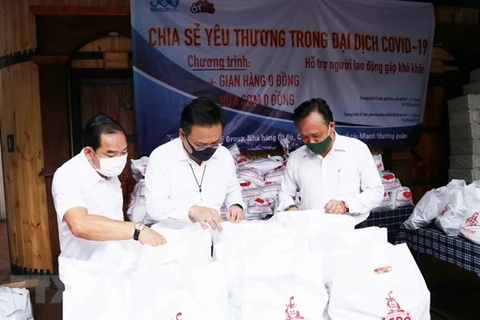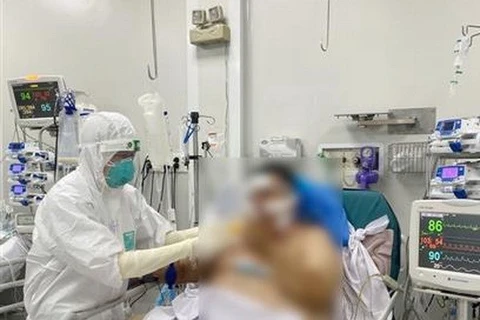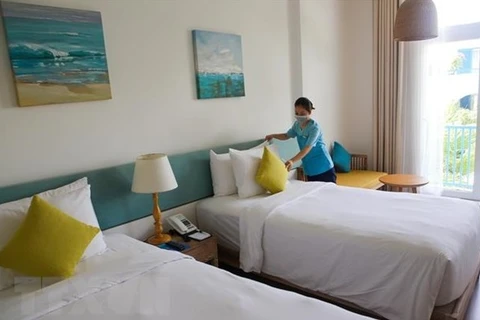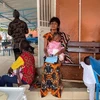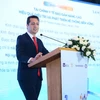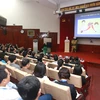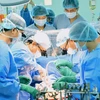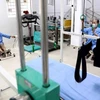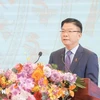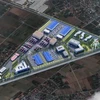HCM City (VNA) – Ho Chi Minh City is building more temporary hospitals for COVID-19 treatment as part of efforts to prepare for a scenario of 60,000 infections, according to Vice Director of the municipal Health Department Nguyen Hoai Nam.
Speaking at a press conference on July 19, Nam said that currently, the hospitals are being constructed with the support of enterprises and expected to double the city’s current capacity of treating 30,000 patients.
Nam said that currently, the conditions in the city are meeting treatment requirements, but it is necessary to prepare for a worse situation amid complicated developments of the pandemic.
The city has classified COVID-19 patients basing on their conditions. Patients showing no symptoms are being treated at temporary hospitals which have a combined capacity of about 6,000 beds, he said.
Nam also affirmed that basically, HCM City now has enough respirators and ECMO supporting COVID-19 treatment, but the city is purchasing more medical equipment to prepare for a worse scenario.
He also rejected the information that temporary hospitals in the city had asked for respirators, clarifying that each hospital has been equipped with four high-pressure oxygen generators, and respirators will be used in central-level hospitals.
Explaining the slow hospitalising of COVID-19 patients, Nam attributed the situation to a lack of smooth coordination among relevant agencies initially, affirming that the city has assigned the 115 Emergency Centre to take the charge of regulating patients so that no patient will be denied.
At the event, Nguyen Hong Tam, Vice Director of the city Centre for Disease Control said that in the past 24 hours, HCM City saw 3,139 new infections, 90 percent of whom were found in quarantine or locked-down areas. Only six were discovered in industrial parks, much fewer than that in previous days, he added.
He revealed that the city has 2,140 F1s undertaking home quarantine in eight districts.
Tam said that as of July 19, 277 local firms had registered to maintain operations with the “three-on-spot” principle (work, eat and rest on the spot) or “one route-two destinations” with an aim to stabilise production and minimise the spread of the pandemic./.
Speaking at a press conference on July 19, Nam said that currently, the hospitals are being constructed with the support of enterprises and expected to double the city’s current capacity of treating 30,000 patients.
Nam said that currently, the conditions in the city are meeting treatment requirements, but it is necessary to prepare for a worse situation amid complicated developments of the pandemic.
The city has classified COVID-19 patients basing on their conditions. Patients showing no symptoms are being treated at temporary hospitals which have a combined capacity of about 6,000 beds, he said.
Nam also affirmed that basically, HCM City now has enough respirators and ECMO supporting COVID-19 treatment, but the city is purchasing more medical equipment to prepare for a worse scenario.
He also rejected the information that temporary hospitals in the city had asked for respirators, clarifying that each hospital has been equipped with four high-pressure oxygen generators, and respirators will be used in central-level hospitals.
Explaining the slow hospitalising of COVID-19 patients, Nam attributed the situation to a lack of smooth coordination among relevant agencies initially, affirming that the city has assigned the 115 Emergency Centre to take the charge of regulating patients so that no patient will be denied.
At the event, Nguyen Hong Tam, Vice Director of the city Centre for Disease Control said that in the past 24 hours, HCM City saw 3,139 new infections, 90 percent of whom were found in quarantine or locked-down areas. Only six were discovered in industrial parks, much fewer than that in previous days, he added.
He revealed that the city has 2,140 F1s undertaking home quarantine in eight districts.
Tam said that as of July 19, 277 local firms had registered to maintain operations with the “three-on-spot” principle (work, eat and rest on the spot) or “one route-two destinations” with an aim to stabilise production and minimise the spread of the pandemic./.
VNA

